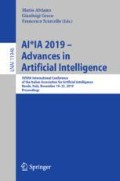Abstract
Predicting the next activity of a running execution trace of a business process represents a challenging task in process mining. The problem has been already tackled by using different machine learning approaches. Among them, deep artificial neural networks architectures suited for sequential data, such as recurrent neural networks (RNNs), recently achieved the state of the art results. However, convolutional neural networks (CNNs) architectures can outperform RNNs on tasks for sequence modeling, such as machine translation. In this paper we investigate the use of stacked inception CNN modules for the next-activity prediction problem. The proposed neural network architecture leads to better results when compared to RNNs architectures both in terms of computational efficiency and prediction accuracy on different real-world datasets.
Access this chapter
Tax calculation will be finalised at checkout
Purchases are for personal use only
Notes
- 1.
The original code used in [23] is available at https://github.com/TaXxER/rnnalpha.
- 2.
- 3.
- 4.
- 5.
- 6.
- 7.
Source code available at https://github.com/nicoladimauro/nnpm.
References
van der Aalst, W.M.P.: Process Mining - Data Science in Action, 2nd edn. Springer, Heidelberg (2016). https://doi.org/10.1007/978-3-662-49851-4
Appice, A., Mauro, N.D., Malerba, D.: Leveraging shallow machine learning to predict business process behavior. In: SCC, pp. 184–188 (2019)
Bai, S., Kolter, J.Z., Koltun, V.: Convolutional sequence modeling revisited. In: ICLR (2018)
Bengio, Y., Ducharme, R., Vincent, P., Janvin, C.: A neural probabilistic language model. JMLR 3, 1137–1155 (2003)
Bergstra, J., Bardenet, R., Bengio, Y., Kégl, B.: Algorithms for hyper-parameter optimization. In: NIPS, pp. 2546–2554 (2011)
Breuker, D., Matzner, M., Delfmann, P., Becker, J.: Comprehensible predictive models for business processes. J. MIS Q. 40, 1009–1034 (2016)
Brier, G.W.: Verification of forecasts expressed in terms of probability. Mon. Weather Rev. 78(1), 1–3 (1950)
Cho, K., et al.: Learning phrase representations using RNN encoder–decoder for statistical machine translation. In: EMNLP, pp. 1724–1734 (2014)
Chorowski, J.K., Bahdanau, D., Serdyuk, D., Cho, K., Bengio, Y.: Attention-based models for speech recognition. In: NIPS, pp. 577–585 (2015)
Devlin, J., Chang, M., Lee, K., Toutanova, K.: BERT: pre-training of deep bidirectional transformers for language understanding. CoRR abs/1810.04805 (2018)
Evermann, J., Rehse, J.-R., Fettke, P.: A deep learning approach for predicting process behaviour at runtime. In: Dumas, M., Fantinato, M. (eds.) BPM 2016. LNBIP, vol. 281, pp. 327–338. Springer, Cham (2017). https://doi.org/10.1007/978-3-319-58457-7_24
Di Francescomarino, C., Ghidini, C., Maggi, F.M., Petrucci, G., Yeshchenko, A.: An eye into the future: leveraging a-priori knowledge in predictive business process monitoring. In: Carmona, J., Engels, G., Kumar, A. (eds.) BPM 2017. LNCS, vol. 10445, pp. 252–268. Springer, Cham (2017). https://doi.org/10.1007/978-3-319-65000-5_15
Glorot, X., Bengio, Y.: Understanding the difficulty of training deep feedforward neural networks. In: AISTATS, pp. 249–256 (2010)
Glorot, X., Bordes, A., Bengio, Y.: Deep sparse rectifier neural networks. In: AISTATS, vol. 15, pp. 315–323. PMLR (2011)
Goodfellow, I., Bengio, Y., Courville, A.: Deep Learning. MIT Press, Cambridge (2016)
Hochreiter, S., Schmidhuber, J.: Long short-term memory. Neural Comput. 9(8), 1735–1780 (1997)
Kingma, D., Ba, J.: Adam: a method for stochastic optimization. In: ICLR (2014)
Krizhevsky, A., Sutskever, I., Hinton, G.E.: ImageNet classification with deep convolutional neural networks. CACM 60(6), 84–90 (2017)
LeCun, Y., Haffner, P., Bottou, L., Bengio, Y.: Object recognition with gradient-based learning. In: Shape, Contour and Grouping in Computer Vision. LNCS, vol. 1681, pp. 319–345. Springer, Heidelberg (1999). https://doi.org/10.1007/3-540-46805-6_19
Polato, M., Sperduti, A., Burattin, A., de Leoni, M.: Time and activity sequence prediction of business process instances. Computing 100(9), 1005–1031 (2018)
Schmidhuber, J.: Deep learning in neural networks: an overview. Neural Netw. 61, 85–117 (2015)
Szegedy, C., et al.: Going deeper with convolutions. In: CVPR (2015)
Tax, N., Teinemaa, I., van Zelst, S.J.: An interdisciplinary comparison of sequence modeling methods for next-element prediction. CoRR abs/1811.00062 (2018)
Tax, N., Verenich, I., La Rosa, M., Dumas, M.: Predictive business process monitoring with LSTM neural networks. In: Dubois, E., Pohl, K. (eds.) CAiSE 2017. LNCS, vol. 10253, pp. 477–492. Springer, Cham (2017). https://doi.org/10.1007/978-3-319-59536-8_30
Acknowlegments
This research is partially funded by the Knowledge Community for Efficient Training through Virtual Technologies Italian project (KOMETA, code 2B1MMF1), under the program POR Puglia FESR-FSE 2014–2020 - Asse prioritario 1 - Ricerca, sviluppo tecnologico, innovazione - SubAzione 1.4.b - BANDO INNOLABS supported by Regione Puglia, as well as by the Electronic Shopping & Home delivery of Edible goods with Low environmental Footprint Italian project (ESHELF), under the Apulian INNONETWORK programme.
Author information
Authors and Affiliations
Corresponding author
Editor information
Editors and Affiliations
Rights and permissions
Copyright information
© 2019 Springer Nature Switzerland AG
About this paper
Cite this paper
Di Mauro, N., Appice, A., Basile, T.M.A. (2019). Activity Prediction of Business Process Instances with Inception CNN Models. In: Alviano, M., Greco, G., Scarcello, F. (eds) AI*IA 2019 – Advances in Artificial Intelligence. AI*IA 2019. Lecture Notes in Computer Science(), vol 11946. Springer, Cham. https://doi.org/10.1007/978-3-030-35166-3_25
Download citation
DOI: https://doi.org/10.1007/978-3-030-35166-3_25
Published:
Publisher Name: Springer, Cham
Print ISBN: 978-3-030-35165-6
Online ISBN: 978-3-030-35166-3
eBook Packages: Computer ScienceComputer Science (R0)

